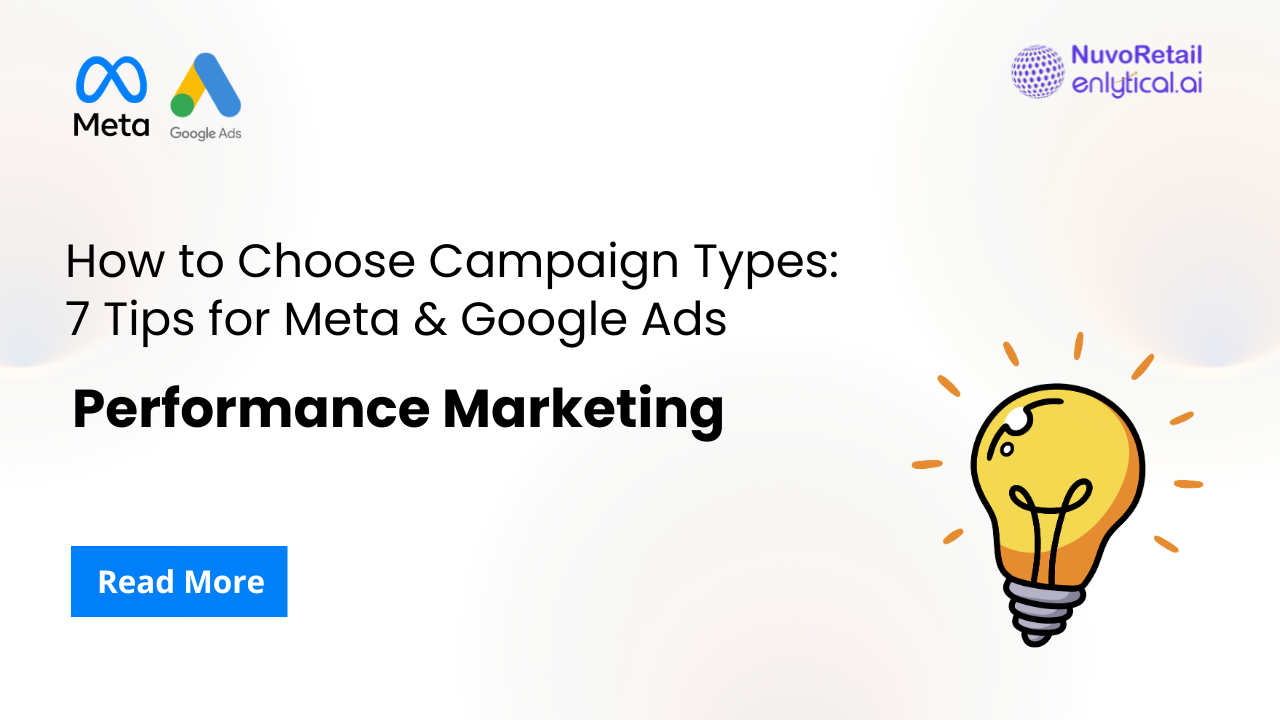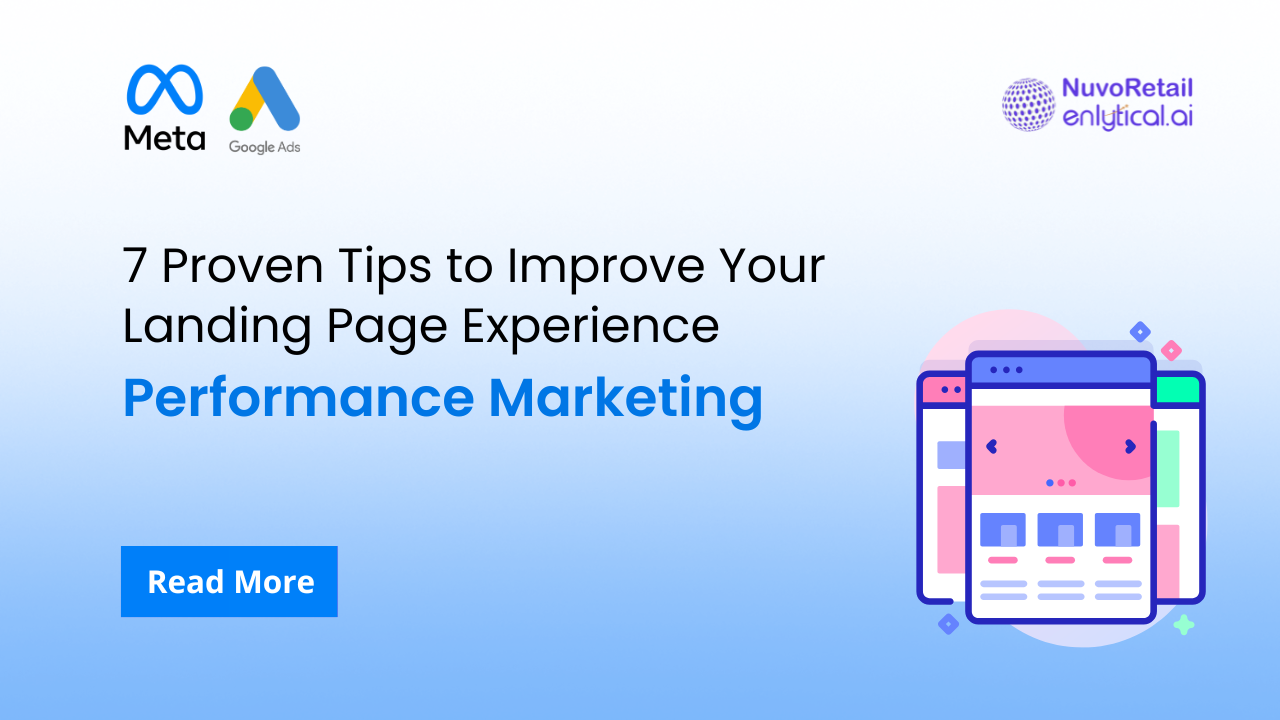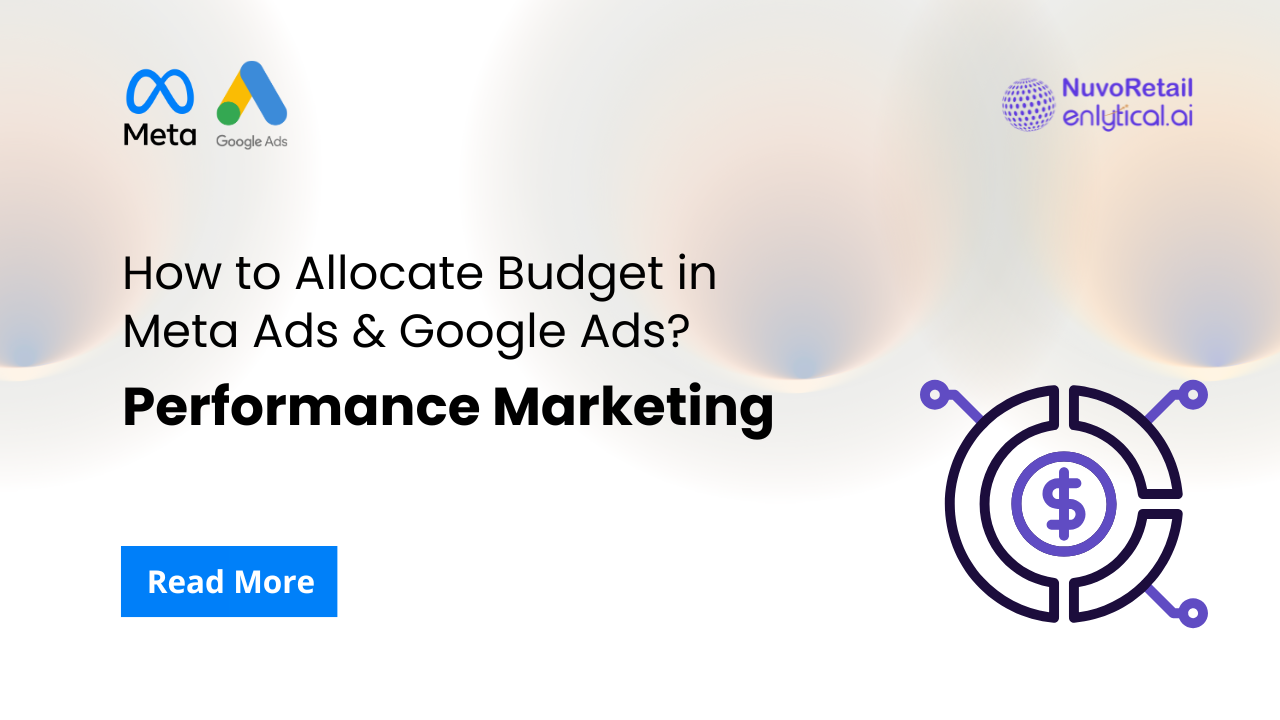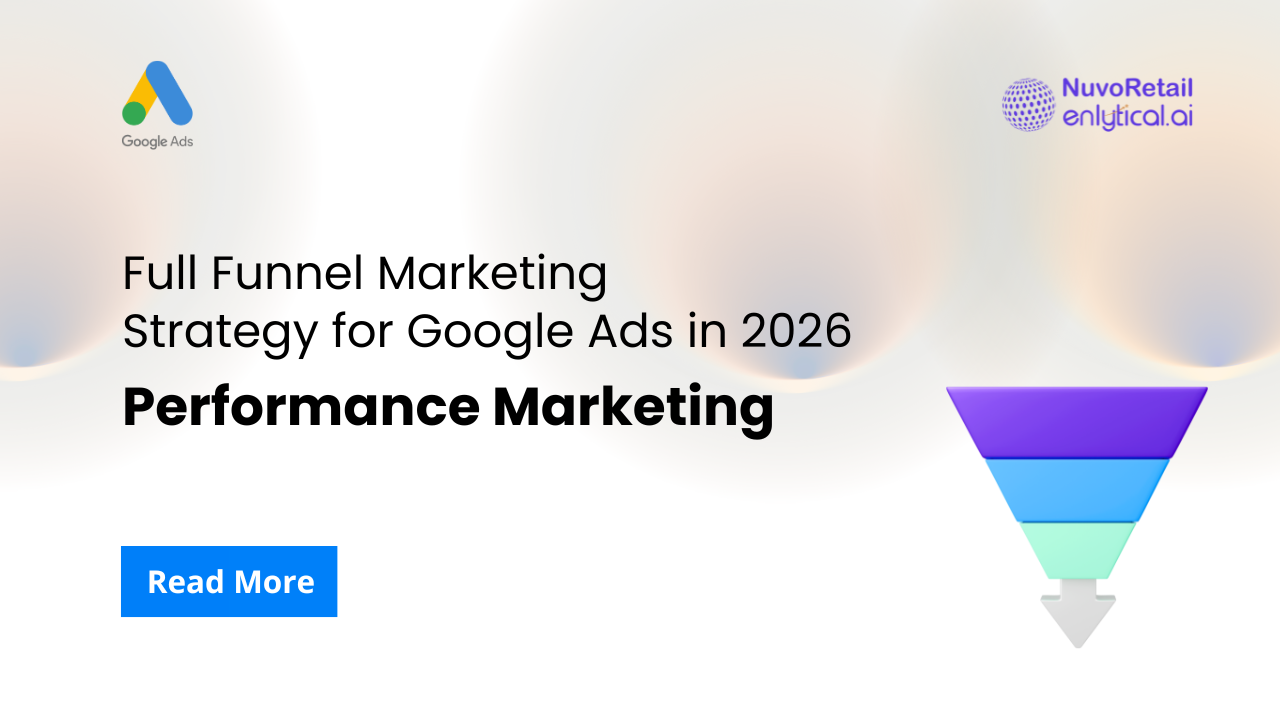In today’s competitive digital landscape, running ads is not enough choosing the right campaign type is what truly drives performance. Whether it’s Google Ads with its search-driven intent or Meta Ads with its powerful audience targeting, selecting the right approach can make or break your marketing ROI. In this blog, we’ll walk you through 7 proven strategies to choose the best campaign types for Google Ads and Meta Ads, helping you maximize reach, conversions, and long-term success.
At NuvoRetail, we specialize in performance marketing services that go beyond basic ad setup. From precision targeting and data-driven insights to campaign optimization across quick commerce and e-commerce platforms, NuvoRetail ensures that every campaign delivers measurable impact. With the right strategies and expert execution, your brand can dominate digital channels and turn clicks into lasting customers.
Table of Contents
- Understanding Campaign Types: The Foundation of Digital Marketing
- Google Ads Campaign Types Explained
- Meta Ads Campaign Types Breakdown
- 7 Proven Strategies to Choose Campaign Types
- Matching Campaign Types to Business Goals
- Common Mistakes When Selecting Campaign Types
- Advanced Tips for Performance Marketing Success
- Conclusion
Understanding Campaign Types: The Foundation of Digital Marketing
Before you can effectively choose campaign types, you need to understand what campaign types are and why they matter. Campaign types are the structural frameworks that determine how your ads are displayed, where they appear, and how you’re charged for them. In performance marketing, the right campaign type can mean the difference between wasting budget and achieving exceptional results.
Both Google Ads and Meta Ads offer multiple campaign types, each designed for specific marketing objectives. As a marketing agency or advertising agency professional, understanding these options is crucial for delivering results. When you choose campaign types strategically, you’re essentially creating a roadmap for how your ads will interact with potential customers.
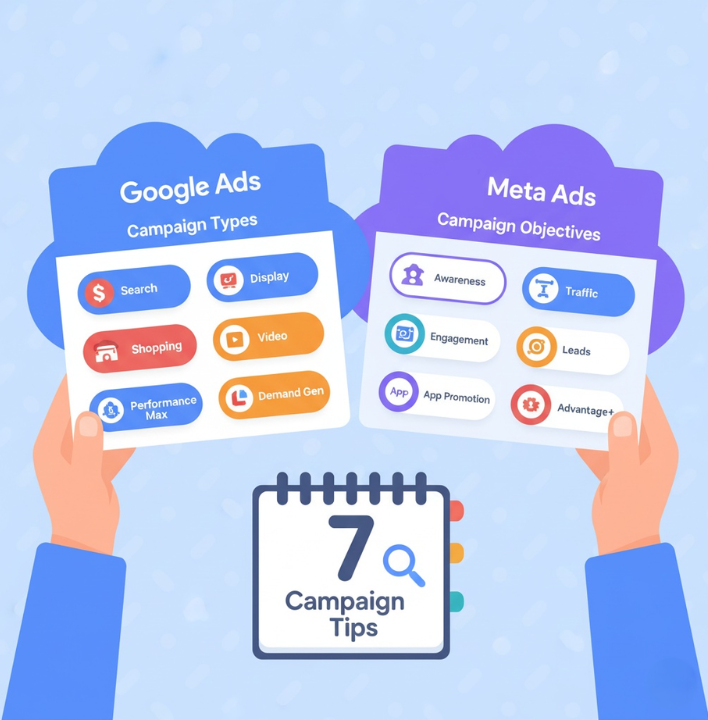
Google Ads Campaign Types Explained
Google Ads provides several campaign types, each serving unique purposes in your digital marketing company’s strategy. Let’s explore each option to help you choose campaign types that work best for your needs.
Search Campaign
A search campaign appears when users actively search for keywords related to your business. This campaign type is ideal when you want to capture high-intent traffic. When you choose campaign types for direct response marketing, search campaigns should be your first consideration. They’re text-based ads that appear on Google search results pages.
Display Campaign
A display campaign uses visual banner ads across Google’s Display Network, reaching over 90% of internet users worldwide. This campaign type is perfect for brand awareness and remarketing. When you choose campaign types for top-of-funnel marketing, display campaigns offer incredible reach at a lower cost per impression.
Shopping Campaign
For e-commerce businesses, the shopping campaign is essential. These ads showcase your products directly in search results with images, prices, and store information. If you sell physical products, you must choose campaign types that include shopping campaigns to compete effectively.
Video Campaign
Video campaigns run on YouTube and across Google’s video partner sites. With video content driving engagement, this campaign type helps you tell your brand story. Choose campaign types that include video when you need to educate, entertain, or inspire your audience.
App Campaign
An app campaign promotes mobile app installations and in-app actions. Google automates these campaigns across Search, Play, YouTube, and the Display Network. When promoting mobile apps, you should choose campaign types that leverage Google’s machine learning for optimal placement.
Performance Max Campaign
The Performance Max campaign is Google’s newest offering, using AI to optimize across all Google channels automatically. This campaign type is perfect when you want to maximize conversions without managing multiple campaigns. Many performance marketing services now recommend you choose campaign types that include Performance Max for comprehensive reach.
Demand Gen Campaign
Demand Gen campaigns focus on building interest and desire for your products or services across Google’s most visual and entertaining surfaces. When you choose campaign types for mid-funnel marketing, Demand Gen helps nurture potential customers who aren’t ready to purchase immediately.
Smart Campaign
Smart campaigns are simplified campaigns for small businesses with limited time or expertise. Google automates most decisions, though you sacrifice some control. Choose campaign types like Smart campaigns when you’re starting out and need simplicity over sophistication.
According to Channable’s comprehensive guide, understanding each campaign type’s unique characteristics is essential for Google Ads success.
Meta Ads Campaign Types Breakdown
Meta Ads (formerly Facebook Ads) operates through the Meta Ads Manager platform, offering campaign types aligned with the customer journey. Understanding how to choose campaign types in Meta’s ecosystem is crucial for social media advertising success.
Awareness Campaign
An awareness campaign maximizes reach and introduces your brand to new audiences. When you choose campaign types for brand building, awareness campaigns help you establish market presence. This campaign type optimizes for impressions and reach rather than direct actions.
Traffic Campaign
A traffic campaign drives users to your website, app, or Messenger conversations. This meta ad type is perfect for increasing website visits, blog readership, or app engagement. Choose campaign types like traffic campaigns when you want to grow your audience and increase site engagement.
Engagement Campaign
An engagement campaign encourages interactions with your content, including likes, comments, shares, and event responses. This meta ads campaign type builds community and social proof. When you choose campaign types for social growth, engagement campaigns create momentum around your brand.
Leads Campaign
A leads campaign collects contact information directly on Facebook or Instagram through lead forms. For B2B marketing agencies and service providers, this campaign type eliminates friction in the lead capture process. Choose campaign types that include lead generation when you want to build your email list or sales pipeline.
App Promotion Campaign
Similar to Google’s app campaign, the app promotion campaign on Meta drives app installations and re-engagement. This campaign type leverages Meta’s detailed targeting to find likely app users. When promoting mobile applications, you should choose campaign types that span both platforms for maximum reach.
Sales Campaign
A sales campaign optimizes for purchases, driving direct revenue. This campaign type is essential for e-commerce businesses and online retailers. When you choose campaign types focused on bottom-funnel conversions, sales campaigns should be your priority.
Advantage+ Campaigns
Advantage+ campaigns represent Meta’s latest innovation in automated advertising, using advanced machine learning to optimize every aspect of your campaign. When you choose campaign types in the Meta Ad Manager, Advantage+ options offer several powerful variations:
Advantage+ Shopping Campaigns: These campaigns automate creative testing, audience targeting, and placement optimization specifically for e-commerce. Unlike traditional sales campaigns, Advantage+ Shopping uses AI to identify the best-converting audiences automatically. When you choose campaign types for online retail, this option significantly reduces manual work while improving performance.
Advantage+ App Campaigns: An evolution of the standard app promotion campaign, this format leverages Meta’s AI to optimize for app installs and in-app events. The system automatically tests creative variations and identifies high-value users, making it easier to choose campaign types that drive quality app growth.
Advantage+ Catalog Ads: This campaign type dynamically showcases products from your catalog to users most likely to purchase. When you choose campaign types for product marketing, Advantage+ Catalog Ads personalize the shopping experience at scale across Facebook and Instagram.
The key benefit of Advantage+ campaigns is reduced complexity. Instead of manually configuring audiences, placements, and budgets across ad sets, you provide Meta’s AI with conversion data and creative assets, and the system optimizes for your goals. Understanding the advantages of Meta Ads campaign performance helps you leverage these automated features effectively.
As noted in ClickGuard’s analysis of Meta Ads campaign types, Meta’s platform is designed to align campaign types with specific business outcomes, and Advantage+ campaigns represent the cutting edge of this alignment.
7 Proven Strategies to Choose Campaign Types
Now that you understand available options, here are seven proven strategies to help you choose campaign types effectively:
1. Start with Clear Objectives
Before you choose campaign types, define what success looks like. Are you building awareness, generating leads, or driving sales? Your objective should directly influence which campaign type you select. A clear goal makes it easier to choose campaign types that align with your business needs.
2. Understand Your Customer Journey
Different campaign types serve different stages of the buyer’s journey. When you choose campaign types, map them to awareness, consideration, and decision stages. For example, awareness campaigns and display campaigns work at the top of the funnel, while sales campaigns and search campaigns excel at the bottom.
3. Consider Your Budget and Resources
Some campaign types require larger budgets to be effective, while others work well with smaller spends. When you choose campaign types, consider both your financial resources and the time you can dedicate to management. Performance Max, Advantage+ campaigns, and Smart campaigns require less hands-on management than traditional search or display campaigns.
4. Analyze Your Competition
Research which campaign types your competitors are using successfully. This competitive intelligence helps you choose campaign types that can differentiate your brand or compete directly. Tools like NuvoRetail’s performance marketing services can help you analyze competitive strategies.
5. Test and Optimize
Don’t commit to just one approach when you choose campaign types. Run A/B tests comparing different campaign types with similar budgets. A/B testing your ads helps identify which campaign types deliver the best results for your specific business.
6. Leverage Platform Recommendations
Both Google Ads and Meta Ads provide recommendations based on your goals. While you shouldn’t blindly follow these suggestions, they offer valuable insights when you choose campaign types. The platforms’ AI has analyzed millions of successful campaigns and can guide your decisions.
7. Monitor Performance Marketing Metrics
Once you’ve chosen campaign types, track the right metrics. Focus on performance marketing metrics like conversion rate, cost per acquisition, and return on ad spend. These metrics tell you whether you need to adjust your campaign type selection.
Matching Campaign Types to Business Goals
The key to successful digital marketing is alignment. Here’s how to choose campaign types based on common business objectives:
For Brand Awareness: Choose campaign types like awareness campaigns, display campaigns, and video campaigns. These formats maximize reach and impressions, introducing your brand to new audiences.
For Lead Generation: Choose campaign types including leads campaigns, search campaigns with lead form extensions, and traffic campaigns to landing pages. These options capture contact information effectively.
For E-commerce Sales: Choose campaign types such as shopping campaigns, sales campaigns, Advantage+ Shopping campaigns, and Performance Max campaigns. These formats are optimized for direct revenue generation with advanced automation.
For App Growth: Choose campaign types like app campaigns, app promotion campaigns, and Advantage+ App campaigns. Both platforms offer specialized features for mobile app marketing, with Advantage+ options providing superior automation.
For Local Business: Choose campaign types including smart campaigns, search campaigns with location extensions, and local awareness campaigns. These options drive foot traffic and phone calls.
When working with a digital marketing company like NuvoRetail, professionals help you choose campaign types that align perfectly with your unique business objectives and budget constraints.
Common Mistakes When Selecting Campaign Types
Even experienced marketers make errors when they choose campaign types. Avoid these common pitfalls:
Choosing Based on Familiarity Only: Don’t choose campaign types simply because you’ve used them before. New campaign types like Performance Max, Demand Gen, and Advantage+ campaigns may deliver better results for your current goals.
Ignoring Platform Strengths: Google Ads excels at search intent, while Meta Ads dominates social engagement. Choose campaign types that leverage each platform’s unique strengths rather than forcing one platform to do everything.
Overlooking Mobile Optimization: Many campaign types perform differently on mobile devices. When you choose campaign types, consider your audience’s device preferences and behavior.
Setting and Forgetting: Campaign types may need adjustment as your business evolves. Regularly review whether you should choose campaign types differently based on performance data and changing objectives.
Neglecting Audience Targeting: The best campaign type won’t succeed without proper audience targeting. When you choose campaign types, simultaneously develop your targeting strategy for maximum effectiveness.
Resisting Automation: Many advertisers resist automated campaign types like Advantage+ and Performance Max due to perceived loss of control. However, these campaign types often outperform manual campaigns when given proper conversion data and creative assets.
Understanding the advantages of Meta Ads campaign performance can help you avoid platform-specific mistakes and embrace beneficial automation.
Advanced Tips for Performance Marketing Success
Once you’ve mastered how to choose campaign types, these advanced strategies will elevate your performance marketing services:
Cross-Platform Strategy: Don’t choose campaign types in isolation. Develop an integrated strategy where Google Ads and Meta Ads campaign types work together, each playing to their strengths in your overall marketing funnel.
Seasonal Adjustments: Choose campaign types differently during peak seasons. For example, shopping campaigns, Advantage+ Shopping campaigns, and sales campaigns should receive more budget during holiday periods, while awareness campaigns might dominate slower seasons.
Audience Segmentation: Within each campaign type, create multiple campaigns targeting different audience segments. This allows you to choose campaign types and customize messaging for maximum relevance.
Budget Allocation Framework: Develop a framework for how you choose campaign types and allocate budgets. A common approach is 60% to proven performers, 30% to scaling winners, and 10% to testing new campaign types.
Leverage Automation Wisely: Newer campaign types like Performance Max and Advantage+ campaigns use significant automation. When you choose campaign types with AI optimization, provide the algorithm with quality conversion data and sufficient budget to learn effectively. These systems typically need 50+ conversions per week to optimize properly.
Feed Quality Matters: For shopping campaigns, Advantage+ Shopping campaigns, and Performance Max campaigns, your product feed quality directly impacts performance. Optimize titles, descriptions, and images before you choose campaign types that rely on catalog data.
Working with an advertising agency that specializes in performance marketing ensures you’re always choosing campaign types that align with current best practices and platform updates.
Conclusion
Learning to choose campaign types effectively is one of the most valuable skills in digital marketing. Whether you’re managing Google Ads, Meta Ads, or both platforms, the campaign types you select directly impact your marketing success. By understanding each option’s strengths, aligning campaign types with your business goals, and continuously testing and optimizing, you’ll maximize your advertising ROI.
Remember that the landscape of digital advertising evolves constantly. New campaign types emerge, platform algorithms improve, and consumer behavior shifts. Stay informed, remain flexible, and don’t be afraid to choose campaign types differently as circumstances change. The introduction of AI-powered options like Advantage+ campaigns and Performance Max represents the future of digital advertising, where strategic thinking matters more than manual optimization.
The strategies outlined in this guide provide a solid foundation, but real expertise comes from experience. Start implementing these insights today, and you’ll quickly develop the intuition to choose campaign types that drive exceptional results for your business.
Ready to Optimize Your Campaign Strategy?
Choosing the right campaign types is just the beginning. Partner with experts who understand the nuances of Google Ads and Meta Ads inside and out. Contact NuvoRetail today to discover how our performance marketing services can transform your digital advertising results. Our team of specialists will help you choose campaign types that align perfectly with your business goals and deliver measurable ROI.
Have questions about campaign types? Drop a comment below, and let’s discuss your specific marketing challenges. Don’t forget to share this guide with fellow marketers who need help choosing the right campaign types for their campaigns!
About NuvoRetail: As a leading digital marketing company, NuvoRetail specializes in performance marketing services that drive real business growth. Our team helps businesses choose campaign types and implement strategies that maximize advertising ROI across all major platforms.
